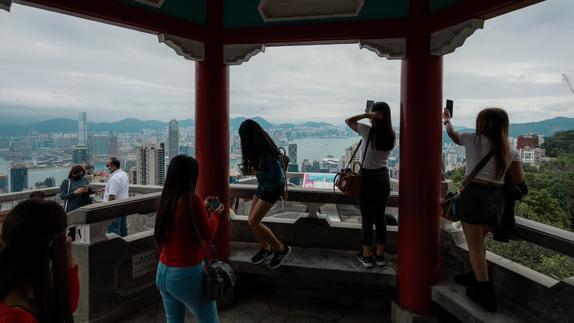 People enjoy the panoramic views from Victoria Peak, Hong Kong on May 2, 2022. (ANDY CHONG / CHINA DAILY)
People enjoy the panoramic views from Victoria Peak, Hong Kong on May 2, 2022. (ANDY CHONG / CHINA DAILY)
HONG KONG - Featuring old-fashioned staircases and pop-culture movie scenes, a meticulously designed "tea house" stood out among the exhibitions at the ongoing International Travel Expo (ITE) in Hong Kong.
Through elements such as antique tea cups and cookies for afternoon tea, the exhibits try to present an elegant lifestyle of many Hong Kongers, said Branden Tong, founder of the tea house located in the Central District of the city.
"Hong Kong is a unique place where East meets West, and we try to convey that idea to all visitors around the world," Tong said.
The tea house was among the exhibits highlighted at the ITE, an annual travel fair that connects global tourism promotional agencies, travel agents as well as international travelers.
Hong Kong, long the meeting point for Chinese and Western culture, is uniquely blessed to showcase arts, culture and sports through tourism.
John Lee, HKSAR chief executive
Themed "Reconnect and Recovery", this year's ITE will run from Thursday to Sunday, featuring many cultural exhibits as the Hong Kong Special Administrative Region (HKSAR) tries to promote art and culture to revive an industry struggling to recover from the COVID-19 pandemic.
READ MORE: Hardship: HK tourism lawmaker hopes govt will support sector
"Hong Kong, long the meeting point for Chinese and Western culture, is uniquely blessed to showcase arts, culture and sports through tourism," said Chief Executive of the HKSAR John Lee Ka-chiu in a written message to the fair.
Kevin Yeung Yun-hung, secretary for culture, sports and tourism of the HKSAR government, said that the local government is sparing no effort in preparing for the return of visitors when circumstances permit.
While taking targeted strategies to control the spread of the pandemic, the city has been making efforts to expand its tourism offerings, including the Hong Kong Palace Museum, a new cultural landmark, said Yeung.
The bureau will foster synergy and accelerate the development of arts and culture, creative industries, sports, and tourism in Hong Kong through better policy integration and coordination, he said.
Overseas exhibitors participating in the ITE already saw cultural tourism as a new growth point for Hong Kong to attract visitors.
ALSO READ: Go high-tech or risk losing out, HK travel agencies told
Vickie Chong, a marketing consultant for the Hong Kong Office of the Tourism Authority of Thailand, said that while tourists from Thailand usually enjoys the local cuisines and doing shopping in Hong Kong, she believes that the new cultural landmarks, such as the M+ Museum and the Hong Kong Palace Museum, will also attract more Thai tourists to visit Hong Kong.
"They love to check in at different sight-seeing spots. I believe these cultural landmarks have the potential to become popular photo spots in the future," Chong said.
Exhibitors from the Chinese mainland is also seeing the unique role of Hong Kong as a gateway for global visitors to learn the richness of Chinese culture.
At the fair, musicians dressed in costumes were playing the horsehead fiddle, or the morin khuur, a traditional bowed stringed instrument played by artists in north China's Inner Mongolia Autonomous Region.
Amuguleng, director and general manager of the Inner Mongolia Hing Yuen (Hong Kong) Company Limited, said that Hong Kong is an important platform for promoting the tourism and local tradition in Inner Mongolia.
"There are a lot of platforms in Hong Kong, for example travel exhibitions, that allow people to get to know more of Inner Mongolia," he said.
The HKSAR recently announced a cut in the COVID-19 hotel quarantine period for inbound travelers flying from overseas or China's Taiwan to three days from the previous seven days, a move that industry insiders said would support local tourism recovery.
Tommy Tam, deputy chairman of the Travel Industry Council of Hong Kong, said that there is currently a great demand for inbound traveling to Hong Kong, and the tourism promotion of the Guangdong-Hong Kong-Macao Greater Bay Area (GBA) as a whole will only add to the momentum.
"Cooperation with other cities in the GBA is definitely an area of focus of our work. We see great potential for tourism cooperation in the area," Tam said.


